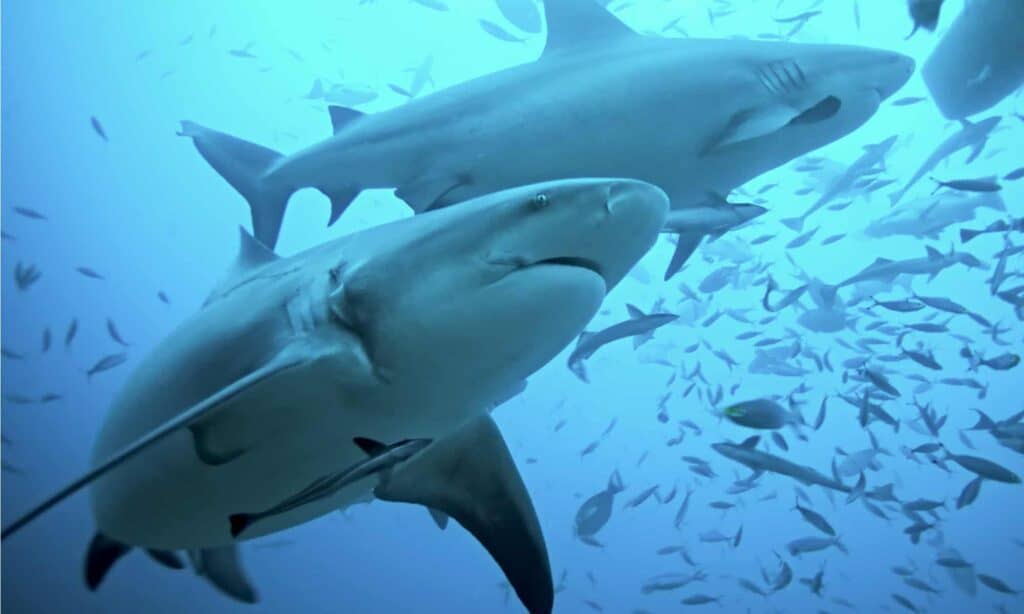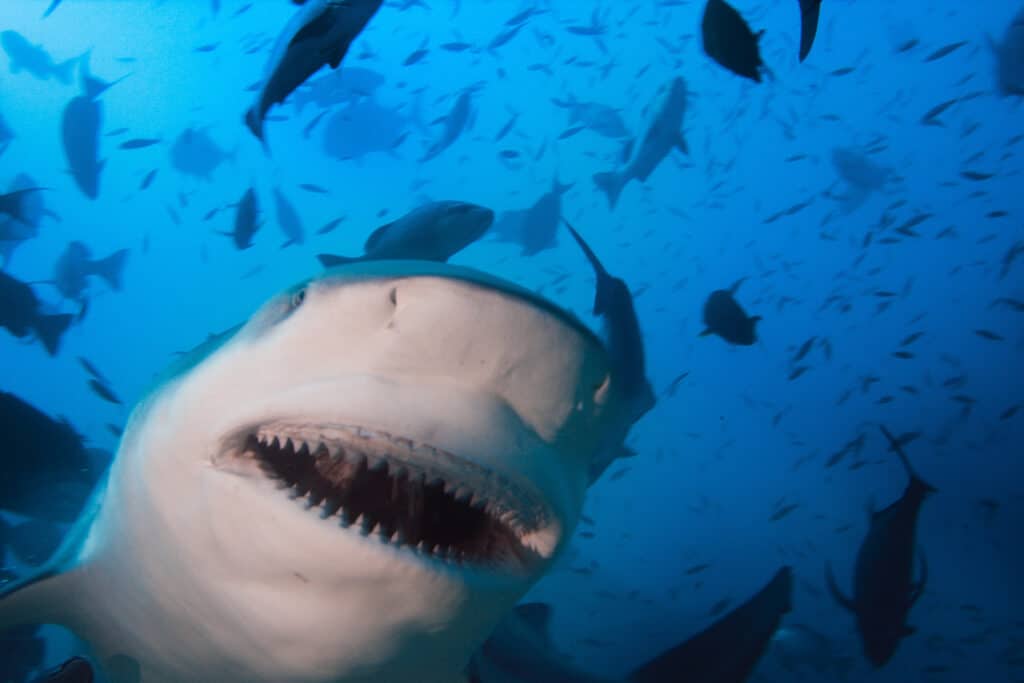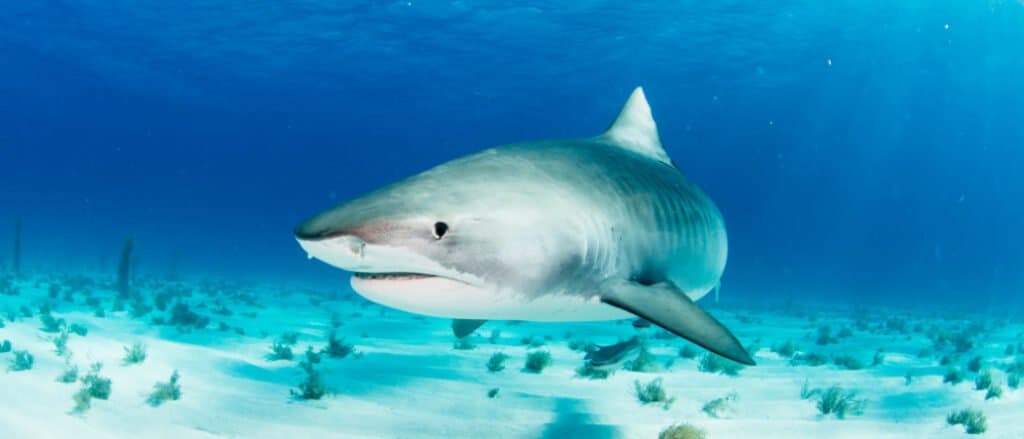Although the chance of actually being killed by a shark is relatively low (statistically you are more likely to be struck by lightning), the fear of sharks is very real. A lot of this fear is attributed to films such as Jaws which portrayed sharks as man-eating monsters, but unfortunately shark attacks do happen. Although the great white is the best known species, is it really the most dangerous? Read on to discover the most dangerous shark in the world!
What is the Most Dangerous Shark in the World?

Bull sharks have an aggressive and unpredictable nature.
©HakBak/Shutterstock.com
The most dangerous shark in the world is the bull shark. Bull sharks have an unpredictable nature and are responsible for many unprovoked attacks on humans. They are widespread and inhabit many coastal regions around the world. They can also swim for miles upstream into lakes and rivers due to their ability to tolerate freshwater.
About Bull Sharks
Bull sharks are powerful apex predators. They prey on a wide variety of fish, marine mammals, birds, stingrays, turtles, and even other sharks. Bull sharks typically reach around 11 feet long, with males being bigger than females. They have robust, stocky bodies and short, blunt snouts.
Bull sharks inhabit warm, coastal waters around the world. They prefer shallow water that is less than 100 feet deep, although they can be found at depths up to 450 feet. However, the most notable feature of bull sharks is their ability to thrive in an environment that they really shouldn’t be able to — freshwater.
There are several species of sharks which are able to tolerate freshwater for a short period. Bull sharks are in the more exclusive category of being able to tolerate it for a longer period though, allowing them even to live in it long term in some cases. Bull sharks are able to tolerate freshwater due to their larger liver. Sharks have oil-filled livers to keep them afloat. However, as freshwater is not as buoyant as saltwater they have a larger liver with more oil in it to compensate. This is also why they have such stocky bodies. There are also a couple of other factors that help them to survive in freshwater. These include having less salt in their bodies than other sharks and having the ability to regulate their bodies depending on whether they are in saltwater or freshwater by producing urea.
Bull sharks are believed to be responsible for the deadly Jersey Shore shark attacks in 1916. These were the inspiration for Jaws due to some of the attacks happening up a creek in fresh and brackish water.
Why Are Bull Sharks More Dangerous Than Great Whites?

Bull sharks frequently inhabit shallow, coastal waters where they are more likely to come into contact with humans.
©Martin Prochazkacz/Shutterstock.com
Great whites are the most notorious of all sharks. They are one of the best known species and also one of the largest, reaching 15 to 16 feet long. Although bull sharks are considered to be more dangerous, great white sharks have a greater number of fatal attacks which are attributed to them. Great whites are responsible for approximately 333 shark attacks, of which 52 were fatal. This is compared to 25 fatal attacks from 117 which were attributed to bull sharks.
However, although great whites have killed more people, bull sharks are considered to be the most dangerous species due to their location and aggressive nature. Bull sharks have an incredible bite force of 6,000 newtons (1,300 pounds). They also have such an unpredictable nature that they are considered by many experts to be more likely to attack a human. They also often inhabit coastal areas where there is a greater chance of them coming into contact with people. Therefore, the greater chance of encountering these sharks means that there is a greater chance of an attack.
Why Do Sharks Attack People?

Many shark attacks happen because the shark is confused, frightened, or curious.
©Willyam Bradberry/Shutterstock.com
Although you’re probably worried about being attacked by a shark, and there can occasionally be unprovoked attacks, it’s important to remember that sharks do not typically prey on humans. Sharks don’t actively hunt us. Instead, most shark attacks happen because they are either confused, frightened, or curious.
If a shark comes across someone in the water or on a surfboard then it may simply mistake them for prey, especially in murky water. If the person is thrashing around then the shark is more likely to assume that it is something edible (like a seal) which is in distress. Other situations which lead to sharks attacking can include the shark being hit by a person, surfboard, or even a small boat.
Which Other Sharks Are Dangerous?

Tiger
sharks are the third most dangerous shark, after bull sharks and great whites.
©Yoshinori/Shutterstock.com
Although the bull shark is considered to be the most dangerous shark in the world, closely followed by the great white, these are not the only two sharks which are dangerous. Tiger sharks are the only other species with a high number of recorded shark attacks on humans, including unprovoked attacks. The number of attacks attributed to them is approximately 138, with 36 which were fatal. Tiger sharks are opportunistic predators which inhabit tropical and subtropical waters, including around the coast. They often reach 10 to 14 feet long and have broad heads with flat snouts. Younger sharks usually have distinctive dark stripes, although these fade as the shark ages.
Another particularly dangerous shark is the oceanic whitetip. These are regarded as being the sharks which are responsible for the deaths of many shipwreck survivors, although the numbers are unconfirmed. Oceanic whitetips can reach 13 feet long and have robust bodies with distinctive white tips on their fins. They commonly inhabit deep, open oceans, although they usually inhabit the upper part of the ocean at depths less that 656 feet. One of the most notorious shark attacks in history is attributed to the oceanic whitetip — the survivors from the USS Indianapolis which sunk in 1945 after it was torpedoed. Potentially hundreds of sailors were killed by oceanic whitetips after they entered the water. However, reports of the numbers varies considerably.
The photo featured at the top of this post is © Havoc/Shutterstock.com
Thank you for reading! Have some feedback for us? Contact the AZ Animals editorial team.







